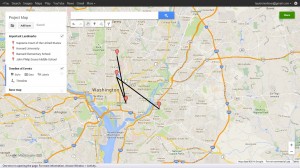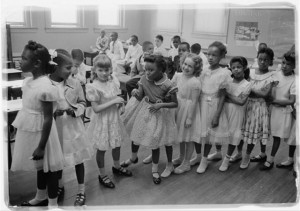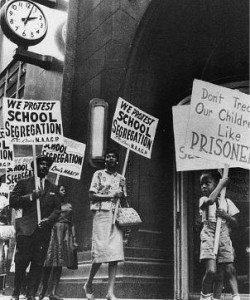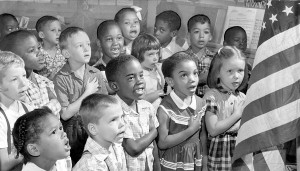Week Eleven: Omeka Exhibit
This exhibit will be a collection of written and visual sources collected from the 1950’s and 1960’s. These primary and secondary sources will reveal the conditions of the country and of the District of Colombia prior to and after integration of schools. By placing visual images, written accounts, videos, etc. by one another conclusions about the history of school integration in Washington DC can be made. Below is a list of the items that will make up this exhibit:
1. A written newspaper article on the history of Washington DC schools. http://www.washingtonpost.com/wp-srv/metro/interactives/dcschools/timeline/?hpid=topnews
2. A written case brief on Bolling versus Sharpe. http://www.oyez.org/cases/1950-1959/1952/1952_8
3. A photograph depicting Barnard School. One of the first schools to integrate following Bolling versus Sharpe.
4. This interactive site provides a background on several different schools and their conditions prior to integration. http://www.wdchumanities.org/bigreadexhibit/exhibits/show/dcsegregatedschools/ward-1
5. This photograph shows a group a protesters in Washington DC. It first appeared in a local newspaper. It reveals the tense conditions that existed at the time.
6. This documentary although it does not specifically focus on Washington DC it does capture the attitudes and conditions that existed at this time. Through interviews first hand accounts are captured from this time period. https://www.youtube.com/watch?v=U9ACS4PgDFA
Together the listed items will provide background on the conditions of the country prior to school integration. This collection will reveal why school integration eventually came about and how the previous conditions of the country influenced court cases such as Bolling versus Sharpe. Finally by analyzing these sources and understanding how they influenced integration the effects can be understood better.
Week Ten: Text Analysis
Text-mining is helpful if you can use it to find a new source. Like if you were looking for sources for a research topic. It would be helpful to search you topic in a database, and then the database would find articles, books, etc. that are on your topic. This would be a system like Google Ngram. Google Ngram was interesting because it allows you to search for books on your topic. It shows how many books were written on this topic and in which years books were published on this topic. Google Ngram searches through its database and pulls books that you may not be able to find on other databases; however, it is only limited to those that Google owns. Although Wordle creates an interesting image it does not help much in the actual research process. It does not help you find any new sources, but only creates a collage of repeated words from the document. Although this is interesting I do not think I would ever use it in an academic setting. Finally Test Voyant did not help me because it did not help me find any new sources, or make sense of sources that I already have. Like Wordle it only documented words that appeared most often. Not in a collage, but in a list. Once again I would not ever use this in an academic setting.
I feel more confident this week in the direction my project will take,as well as what exactly I will be doing my research on. I started with a broad topic that included a large amount of information. My vague plan has been streamlined, and I have a set research goal in mind thanks to writing my research proposal a few weeks ago. Last weeks map was helpful in really outlining the project. I figured out exactly what I wanted my project on and how I would go about doing this research. I have had difficulties, however, on finding a wide arrange of diverse secondary and primary sources to be used in the research of my project. Omeka has helped me a lot in creating a way to easily cite all of the sources I have also discovered Jstor has also been helpful in finding a large amount of sources to be used for research. As I come to the end of my research I am now ready to start piecing out my information in order to answer my research question and really understand the history of the integration of the John Phillips Sousa Junior High School.
Week Nine: Project Map
 https://mapsengine.google.com/map/edit?authuser=0&hl=en&mid=zYv61qH1CLtU.ktQf0Bjbx7Ms
https://mapsengine.google.com/map/edit?authuser=0&hl=en&mid=zYv61qH1CLtU.ktQf0Bjbx7Ms
Making this map was simple. Google maps is an easy to use program. I started by choosing important places that were prevalent in the moments before and after this court case. I began with the actual school that began the case for integration. I then linked this to Howard University where the lawyer who argued for integration taught. Next I connected the Supreme Court where the case was actually fought. Finally I connected Barnard Elementary School, one of the many schools in the Washington DC area to integrate following the court case Bolling vs. Sharpe. I connected these events by the order in which they occurred.
I struggled at first with how to create layers, but this issue was easily resolved. Google maps offers online helps tools that explain step by step of how to complete any task you could ever want. I think this is an useful tool for any assignment that includes different locations, especially when discussing historical events. After making this map I realized how interconnected the events were in both time and space. After making a visual timeline I could really see how each event led to another.
Week Five: Research of Final Topic
After completing my preliminary research, I have eliminated two possible topics for my final project, I have decided to look more in to segregation and then eventually integration in schools in Washington DC. Just in my preliminary research I found an ample amount of information on this topic. I will continue my research on this topic by looking through the website I found ran by the Smithsonian Museum of American Art. This website offered a substantial amount of information on this one topic, such as supreme court cases and information on schools before and after integration. After that I would continue my research on the site for the Library of Congress. This site offers primary and secondary sources from pictures, to books, to newspaper articles. From this site I can really learn what the conditions were like at the time from first hand accounts. Also I can learn what scholars think of segregation now focusing primarily in the nation’s capital. Finally I will conclude my extensive research by logging on to George Mason University libraries’ home page and then search the database “American: History and Life.” Then I will complete a boolean search for topics such as segregation and schools and Washington DC. This will also provide me with primary and secondary sources. The primary sources will give me insight on what was actually occurring within the capital at the time. The secondary sources will show what scholars believe happened, as well as how segregation has effected the nation capital’s schools today.
Week Four: Research on Possible Topics
As I begin my final project, I first begin by starting to look for possible topics. My first idea is to study the differences between schools in various parts of Washington D.C. Primarily focusing on comparing areas with higher income against those with lower incomes. I would like in my research to discover if there are major differences in the education systems depending on where you live within the nation’s capital. I would also like to analyze past events and try to determine if there were any large factors that led to any discrepancies between school systems in different areas. This topic is particularly interesting to me because I am planning on going in to the teaching field, particularly in this area. I believe researching this topic would aid me when I choose exactly where to live later in life. I also think overall this topic is important because our nation’s capital should have the best school systems in order to act as a role model for other schools in our country. If schools are not up to this standard the government should do something to fix this problem. I would begin my research for this particular topic by searching “education in Washington D.C” in an inPrimo search on our university libraries’ home page. I would then use the search results to find current articles on the conditions of education in the city now. Next I would search for the past conditions of schools in the capital by limiting the search results to only those published before the 1900’s. After gathering all this information I would then compare time period, as well as areas of high income versus those with lower income.
A second possible topic that I am considering also has to do with the schooling system in Washington D.C; however, this topic deals specifically with segregation and the movement towards integration. I would analyze segregations long lasting effects on the capital by first researching the past history, and then comparing the results to the conditions now within school systems that were once segregated. I believe this is an important topic because conditions in the past effect conditions in schools today, and unfortunately there are many issues within school districts today. I would like to see if there is any correlation between the two. After doing some quick research on this topic to see if it was even an option, I discovered a helpful site created by the Smithsonian Museum of American History. This site offers a great deal of information specifically on this topic. For example it lists the names of schools that were segregated, there locations within the capital, as well as the supreme court cases that existed that eventually ended segregation within the school system. Finally I would finish my preliminary research by looking up conditions of schools in D.C. today to see the effects segregation has had on schools. I would once again complete an inPrimo search on the university school’s site, but limit the dates to those after 2001. I would then compare both results to see if there is any correlation between conditions now and segregation of schools in the past.
The final topic that I am considering is unlike the other two that I previously mentioned. My final topic deals with how the use of drugs has shaped the history of Washington D.C. Drug use has shaped American history overall, but I would like to focus specifically on how it has shaped history in the nation’s capital. I think this is important because unfortunately not only has drug use changed life in the past, but it still is a big part of life in D.C today. I would do research for this topic by performing a search on the Infoguides on George Mason University’s library page. I would then go to the history section and search in the America: History and Life area. Finally I would perform a boolean search for drugs and then Washington D.C. From this I would search through the articles for any that would shed light on my intended topic. After gathering this information I would then begin to piece together how drug use shaped the past of Washington D.C.


 1 Comment
1 Comment